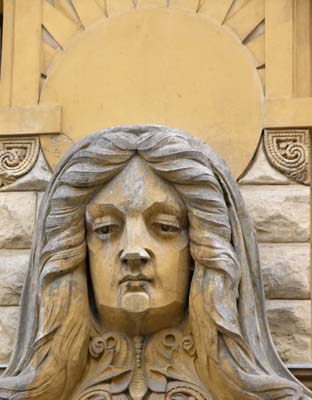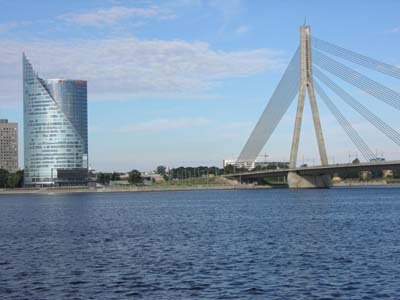The way from Tallinn to Riga was
done in two days with an escapade by the local roads towards the port of Virtsu then towards the balneal city of Pärnu. The town of Pärnu is well
attended by local tourism. The architecture of the city still presents
many marks of the Soviet era.
The
crossing of the border took place at Ikla in Estonia, with a passage to
the idle, and at Ainazi in Latvia, with a stop for a visual control of
the passport.
The state of the A1 road
in Latvia is rather poor. It is under repair with the
finance assistance of the European Union. In the two countries
the landscapes are flat. Forests of leafy trees and thorn-bush are
abundant. Cultures and breeding are rather sparse.
Riga was founded in 1201 by the Albert bishop who evangelized Latvians on order of the Pope. It was accompanied by German crusaders. The evangelization was done with the wire of the sword, massacres and plundering. Latvia was attached to the Germanic empire until XVIth century. It was then the stake of covetousness of the Swedes, of the Poles then Russians. Finally it fell under the rule of Nazi totalitarianism then Soviet one. It recovered its independence on August 21, 1991.

The Castle of
Riga
Office of the President of the
Republic

The cathedral
Lutheran
it contains an organ of 6,718
pipes !

The catholic
church
Our Lady of Sorrow

The house of Blackhead
an organisation of unmarried foreign merchants
on the
left the Schwab house houses the Tourist Information centre
The Art nouveau architecture developed in Riga in the end of XIXth century at the time of the demographic explosion which involved the revival of the town planning of the City. This Art nouveau is contrary to that of Vienna symbolized by the movement of the “Secession”. It was the birth of a properly Latvian art. The visit of the most outstanding buildings of this period shows the ravages of time following the abandonment of this inheritance during the years of occupation. The classification of Riga to the Inheritance World of Humanity allows the progressive restoration of the monuments.

The n°8 of the Smilsu street
Building Art
nouveau
Two beautiful naked young
women

The n°25/29 of the Jauniela
street
Mascaron surmounted with a
sun

The n°10b of the Elizabetes
street
Building designed by
Eisenstein
Peacock decorated with severe
faces

The monument of
Freedom
Young woman holding up three
stars
symbol of the three provinces of
Latvia

Pierre
commemorative
Massacre hundreds of
Jews
in the Great Synagogue

The revival of
Latvia
Modern building close to a
bridge of the Soviet era
The town of Riga is a true treasure of architecture. All the artistic movements are represented. The many museums are a complement essential to the comprehension of the evolution of the city in relation to its often animated history. In Riga as in the two other Baltic States the Russian speaking minority is very important. It is not integrated not having learned the Latvian who is a necessary condition to acquire the Latvian citizenship.